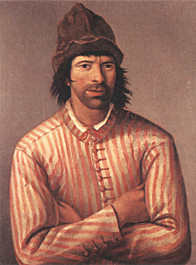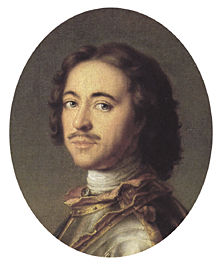For all its' impressive size the Neva River is only 42 miles long. At Smolnyi the river is a vast 2100 feet wide and the pallid surface of the Neva can be deceptive for the river contains rapid and treacherous currents. The main river breaks up into smaller rivers as it makes for the Gulf of Finland, creating many islands. The vast and marshy Neva delta was an unusual place to build a capital city. Not only was the climate damp and dreary, but for many months of the year the region was caught in the grip of a long and dark winter. The short northern summer was a dramatic contrast - a season in which nature played a fast game of catch up and the sun shown long into "White Nights" which made the city famous.
 Left: Peter the Great as a young man exploring Western Europe.
Left: Peter the Great as a young man exploring Western Europe.
Peter the Great built his new capital through the efforts of serf labor and thousands of his poorest subjects died in the building of the city. The curse of these unwilling sacrificial victims to Peter's glory was a reoccurring theme for generations of haunted Petersburg poets and artists, who experienced pangs of guilt over the origins of their beloved city, which they painfully realise, was built upon the bones of those who toiled and died in its' construction.
Tsar Peter's "invitation" for his Muscovite nobles and entrepenurial citizens to join him in his new "European" paradise on the Gulf of Finland was met with scant enthusiasm. Few Russian citizens answered the Tsar's call willingly. Never one to hesitate to issue an order because of the hardships his command might inflict on his subjects (no matter how high-born), Peter ordered his aristocrats to share with him the dubious benefits and certain deprivations of his pioneer city. There was plenty of empty space to be filled in the new city and Peter expected the nobles to follow his lead in establishing Dutch-style palaces there.
 Left: Peter the Great when he was older.
Left: Peter the Great when he was older.
At first, because of the need for fast construction to house its' requisitioned population, most of the city was built of wood - 2,000 wooden structures were erected in a few short years - but Peter was determined his city was to be built of stone and the Tsar issued an order that every man entering the city was to bring a stone with him in aid in building.
From the outset Petersburg was a city of orderliness and stern imagination which ignored the facts of climate and terrain. Broad wind-swept squares, long dank canals and straight-as-an-arrow boulevards were planned on a rigid grid pattern, seemingly without concern for comfort of the future inhabitants of the city. Peter's vision for his Petersburg was a design born after his own experience of Amsterdam, London and Paris and his desire to outdo them all in grandeur. This very un-Russian approach to urban planning was in direct contrast to the old capital, Moscow, with its' winding lanes and organic street plan built on hundreds of years of urban evolution and tradition. Petersburg would always be a city of the Tsars and their bureaucrats - vast, impressive and ordered.
The population quickly grew from a few thousand in the early 1700's to 300,000 in 1800. By 1900 Petersburg had exploded to almost two million people; and this growth brought dark realities with it - in 1900 Petersburg was one of Europe's largest - and most unhealthy - cities.
The city built on the fringe of the wilderness in the first years of the eighteenth century quickly transformed the environment. In the 1760's a citizen of Petersburg could proudly dip his glass into the Neva River and drink it down without fear, for the soft waters of the Neva were renowned for their cleanliness and Neva waters were even believed to possess health-building properties. By the mid 1800's this was no longer true. The immense growth of population and industry in the area was more than the natural eco-system could support. Focusing on superficial effects of grand architecture, the Tsars and city officials neglected public works projects - such as an adequate sewage system - and the citizens of St. Petersburg paid the price in undrinkable city water and rampant diseases such as cholera and diptheria which hit the city regularly - killing thousands.
Next photograph: St. Issac's Cathedral and the Monument to Nicholas I
For a small map of the St. Petersburg area click here.
To see a large map of the center
of St. Petersburg go here.
Comments on the website should be sent to Bob
Atchison.

